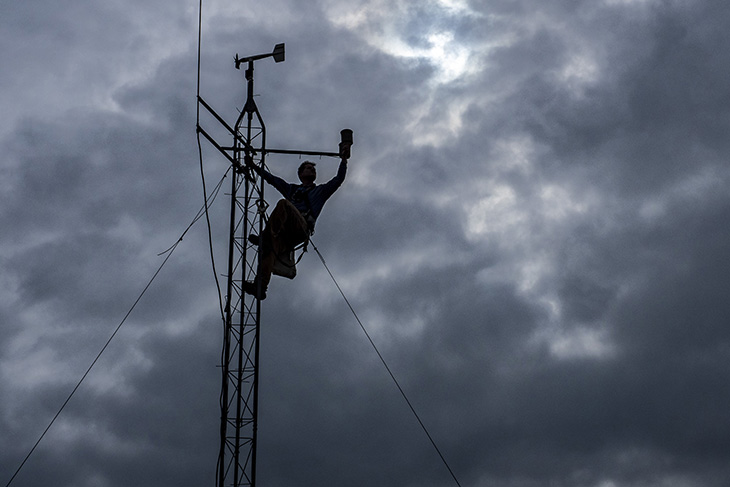
State meteorologist calls Oklahoma Mesonet ‘a forecaster’s dream’
Wednesday, April 24, 2019
News 9 Meteorologist Lacey Swope calls the Oklahoma Mesonet a “blessing,” one easy to overlook by Oklahomans who might think every state has a similar system of weather and environmental monitoring.
“The value of having accurate, needed and updated real-time data cannot be overstated,” she said. “It’s not just weather forecasting. It’s now-casting. The Oklahoma Mesonet literally helps us save lives.”
The Oklahoma Mesonet, a world-class network of environmental monitoring stations that provide updated information every five to 10 minutes, is celebrating its 25th anniversary in 2019. A system of 120 stations with at least one in every county, the network was designed and implemented by cooperating scientists at Oklahoma State University and the University of Oklahoma, with the two universities continuing to provide valuable subject-matter expertise to this day.
A University of Oklahoma alumna, Swope worked in other states before returning to Oklahoma and joining the News 9 weather team. She explains how other states might have only 10 to 20 monitoring stations, and even those typically do not provide the breadth of information available through Oklahoma Mesonet sites. They also do not provide the frequency of updates Swope feels are key to knowing what is going on in real time.
“The constant flow of in-depth above-ground and below-ground data allows state meteorologists to more easily and accurately determine where the dry line is and how fast a weather front is moving, and similar factors that are important to reporting on tornadoes, thunderstorms, floods and wildfires,” she said. “We’ve also got 25 years of accumulated historical data to assist in weather predictions, letting us better project the severity of events from certain environmental factors. That is a forecaster’s dream.”
National Weather Service Director Louis Uccellini agrees, adding a particular benefit provided by the Oklahoma Mesonet has been to let other states across the nation see what is possible in terms of weather and environmental monitoring.
“Up to 40 states have attempted to emulate the Oklahoma Mesonet, though most have not as yet managed to provide the same level of monitoring and access to real-time information,” he said. “Oklahoma’s pioneering work in providing mesoscale data is something to which all states should strive. Do a little research and the historical data can provide you with a wealth of knowledge.”
Uccellini is quick to point out that while people often default to discussion of extreme weather events, 25 years of accumulated Oklahoma Mesonet data is important in helping to ensure best management practices are followed in a wide number of professions and activities: Minimizing stormwater runoff from construction projects, calculating the proper time to apply fertilizer and pesticides in urban lawns or agricultural fields, reducing the chance of wildfires through properly timed applications of prescribed burning, and many more such examples.
“As an OU student, I always felt fortunate at the way my classes allowed us to interact with Oklahoma Mesonet professionals and everyone else at the state’s National Weather Service offices,” Swope said. “I’m blown away by how easy it is for people today to just get on their phones, call up the app and take advantage of Mesonet information.”
An Oklahoma native whose family ties are in Green Country, Swope lauds how the Oklahoma Mesonet makes it easy for anyone and everyone to do weather-related research.
“It’s not just meteorologists and scientists,” she said. “I first became interested in weather forecasting while growing up, in large part because I was an avid angler and hunter. Outdoor enthusiasts rely on knowing what the weather is and will be doing. The Oklahoma Mesonet literally makes accumulated data available with just the click of a mouse or touch of a button.”
Scientists and specialists with OSU’s Division of Agricultural Sciences and Natural Resources’ two state agencies have been involved with the Oklahoma Mesonet since its inception. One primary reason why is the wealth of above-ground and below-ground data provided is an important research and advisement tool, with a number of valuable short-term and long-term applications statewide.
Research depends on high quality, timely data to develop recommendations for farmers, ranchers and homeowners, reminds Keith Owens, OSU associate vice president for DASNR’s statewide Oklahoma Agricultural Experiment Station system.
“Should I irrigate, or is rain likely? What are the chances for wildfire in my area? Is a drought likely to persist? The answers to these and many other questions depend on the data from the Mesonet sites,” Owens said. “The Mesonet’s 120 stations measuring environmental conditions and soil moisture are an extremely valuable source of long-term data.”
The Oklahoma Mesonet is available for use by the public. Find it online at mesonet.org or by visiting the App Store at Google Play or iTunes. The Oklahoma Mesonet is funded by the State of Oklahoma, partnerships with federal agencies, private-sector user fees, and grants and contracts.
MEDIA CONTACT: Donald Stotts | DASNR News and Media Relations | 405-744-4079 | donald.stotts@okstate.edu
